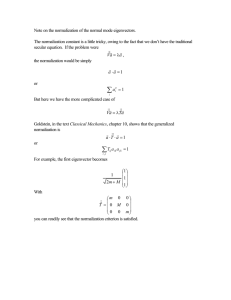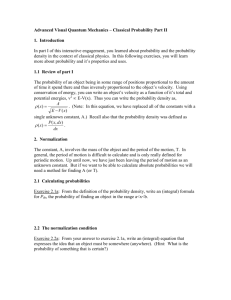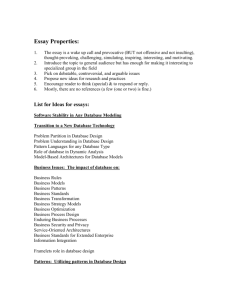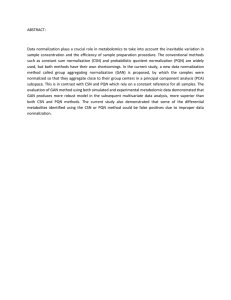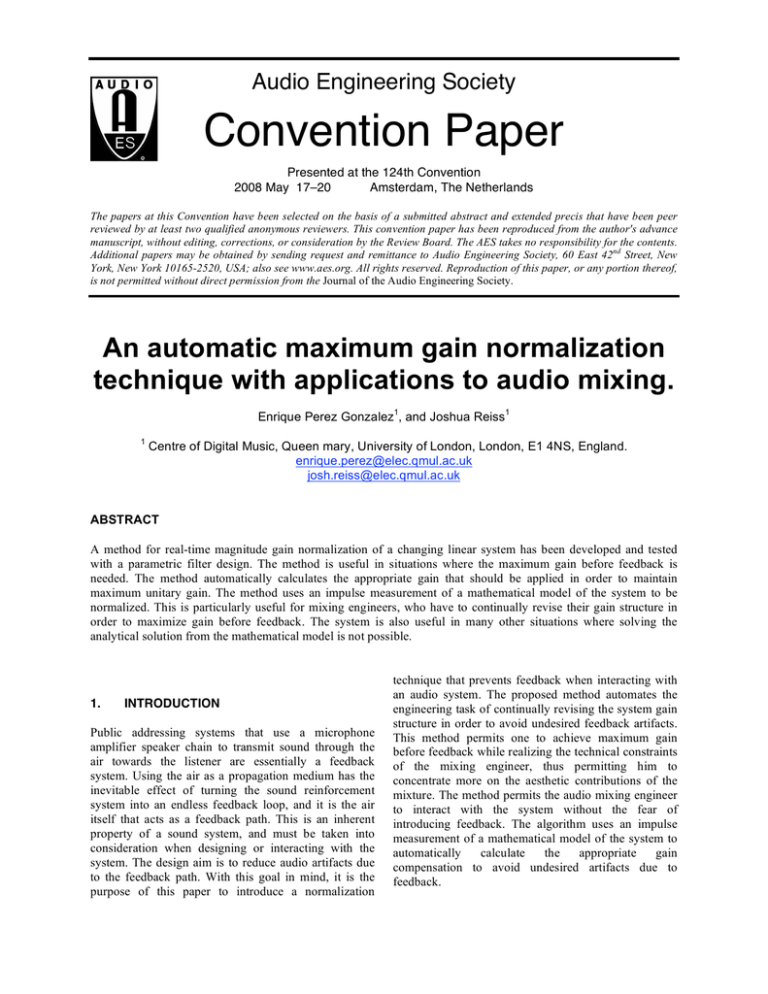
Audio Engineering Society
Convention Paper
Presented at the 124th Convention
2008 May 17–20
Amsterdam, The Netherlands
The papers at this Convention have been selected on the basis of a submitted abstract and extended precis that have been peer
reviewed by at least two qualified anonymous reviewers. This convention paper has been reproduced from the author's advance
manuscript, without editing, corrections, or consideration by the Review Board. The AES takes no responsibility for the contents.
Additional papers may be obtained by sending request and remittance to Audio Engineering Society, 60 East 42nd Street, New
York, New York 10165-2520, USA; also see www.aes.org. All rights reserved. Reproduction of this paper, or any portion thereof,
is not permitted without direct permission from the Journal of the Audio Engineering Society.
An automatic maximum gain normalization
technique with applications to audio mixing.
1
Enrique Perez Gonzalez , and Joshua Reiss
1
1
Centre of Digital Music, Queen mary, University of London, London, E1 4NS, England.
enrique.perez@elec.qmul.ac.uk
josh.reiss@elec.qmul.ac.uk
ABSTRACT
A method for real-time magnitude gain normalization of a changing linear system has been developed and tested
with a parametric filter design. The method is useful in situations where the maximum gain before feedback is
needed. The method automatically calculates the appropriate gain that should be applied in order to maintain
maximum unitary gain. The method uses an impulse measurement of a mathematical model of the system to be
normalized. This is particularly useful for mixing engineers, who have to continually revise their gain structure in
order to maximize gain before feedback. The system is also useful in many other situations where solving the
analytical solution from the mathematical model is not possible.
1.
INTRODUCTION
Public addressing systems that use a microphone
amplifier speaker chain to transmit sound through the
air towards the listener are essentially a feedback
system. Using the air as a propagation medium has the
inevitable effect of turning the sound reinforcement
system into an endless feedback loop, and it is the air
itself that acts as a feedback path. This is an inherent
property of a sound system, and must be taken into
consideration when designing or interacting with the
system. The design aim is to reduce audio artifacts due
to the feedback path. With this goal in mind, it is the
purpose of this paper to introduce a normalization
technique that prevents feedback when interacting with
an audio system. The proposed method automates the
engineering task of continually revising the system gain
structure in order to avoid undesired feedback artifacts.
This method permits one to achieve maximum gain
before feedback while realizing the technical constraints
of the mixing engineer, thus permitting him to
concentrate more on the aesthetic contributions of the
mixture. The method permits the audio mixing engineer
to interact with the system without the fear of
introducing feedback. The algorithm uses an impulse
measurement of a mathematical model of the system to
automatically
calculate
the
appropriate
gain
compensation to avoid undesired artifacts due to
feedback.
Perez Gonzalez et al.
1.1.
Automatic Normalization Technique
Understanding acoustic feedback
Feedback is the result of a retro-alimentation of the
output signal of a system to its input. In an acoustic
system these artifacts are introduced due to the feedback
path and can be positive and negative feedback
contributions. A simplified diagram of an acoustic
feedback system is presented in Figure 1. The source
signal is picked up by a microphone, transformed by
equalization, amplified and played back through a
speaker at the output. This is then attenuated and
delayed as the output is transmitted through air, and
summed with the input signal. HETOT(x) is the electronic
feed-forward transfer function of the system, and it is
the result of the product of the individual transfer
functions of the signal chain given by the microphone
equalizer amplifier and speaker. H ATOT(x) is the acoustic
transfer function of the system.
marginal condition before howling, then boosting the
equalizer will introduce an undesired feedback artifact,
and performing a cut on the equalizer will permit the
system to remain stable. Therefore, a normalization
technique which enables relative gain changes while
forcing the transfer function of a linear system to have a
maximum peak of 0dBs will preserve the stability of the
system .
1.2.
Achieving maximum gain before
feedback.
To maximize the acoustic gain while avoiding feedback,
the system should have a flat frequency response which
falls below the threshold for acoustic feedback. Figure 2
shows the acoustic measurement of the frequency
response of an audio system before and after
optimization. The 0dB mark represents the threshold
before feedback. The area between the frequency
response and the 0dB mark represent unused system
gain. It is the goal of an audio system engineer to
minimize this unused area by flattening the frequency
response of the system. This ensures a system with no
coloration with the added benefit of maximizing gain
before feedback. To achieve maximum gain before
feedback audio operators have relayed mainly on
equalizers [3], delay and feedback cancellation
techniques.
Figure 1 Model of a sound reinforcement feedback
system.
For this paper we will only be concern with undesired
feedback phenomena, properly known as howling [1] or
Larsen effect [2]. This is a state in which system gain
exponentially increments out of control, causing an
undesired audible pitch. The feedback causes the audio
system to behave in an unstable manner. Therefore, this
condition must be avoided at all cost.
Given the acoustic model in Figure 1, the system will
introduce undesired howling artifacts if equation 1 is
satisfied.
HETOT(x)⋅ H ATOT(x)>=1
(1.)
If, for example, the equalizer transfer function gain,
HeEQ(x), is 0dBs when flat and the overall electronic
transfer function of the system HETOT(x) is on the
Figure 2 Acoustic measurement of the frequency
response of a audio system. The dash-dotted (-⋅-⋅-) line
represents the threshold for maximum gain before
feedback, the dashed line (- - -) represents the frequency
response of a non-optimised acoustic system and the full
line () is the frequency response of an optimized
quasi-flat system.
AES 124th Convention, Amsterdam, The Netherlands, 2008 May 17–20
Page 2 of 8
Perez Gonzalez et al.
Automatic Normalization Technique
In recent years, our understanding of the acoustic
feedback phenomena and when equalization can be
achieved has improved. Currently, measurement
techniques like, time delay spectrometry [4] and source
independent measurements [5] have become more
widely available, making the use of equalizers and delay
lines more of a technique rather than a matter of skill.
Also current design techniques and modern electronics,
acoustics and speaker technology make a flatter
frequency response a reality. Although the proper
design of audio systems still requires a great amount of
knowledge from the system engineer, a close to flat
frequency response system which maximizes the gain
before feedback is now a reality. The process of
achieving this is commonly known in the industry as
aligning, in time and frequency, a system. The full
details of this process are beyond the scope of this paper
but more on this can be found on [6].
the model deviates it can introduce distortion and
artifacts. It can even cause undesired feedback artifacts,
which should not have been there. For this reason it has
mainly been applied for speech systems where
conditions are controlled. It is currently not consider a
good candidate for sound reinforcement.
The other important method of achieving maximum
gain before feedback is by the use of feedback
cancellation. Currently there are four main feedbackcontrolling techniques [2]. The first one consists of
slightly frequency shifting the output signal so that the
electronic transfer function is out of alignment with the
acoustic transfer function, this causes a destructive
interaction between the input and the acoustic feedback
path, which effectively reduces feedback. In practice it
can achieve up to 3 dBs increase in gain before
feedback. This method is effective for speech
applications but is not suitable for music. This is due to
the simple reason that it modifies pitch, which would
result in undesired atonal music.
Currently, there is no optimal feedback cancellation
method for music which offers a substantial
improvement in gain before feedback without dangerous
side effects. Therefore, it is the belief of the authors that
if system alignment and an acoustic flat frequency
response are currently achievable, then there is little
need for feedback cancellation techniques. For this
reason, we present a normalization technique which
helps preserves system stability rather than another
feedback cancellation technique. The aim is to prevent
howling before it happened rather than suppress it after
it has happened.
The second feedback control technique is the all-pass
filter approach. This is used to invert the phase of a
potential feedback frequency. Unfortunately this
technique is only useful with low delay systems with a
prominent resonance. When applied to a system with
flat frequency response it causes the feedback to jump
endlessly from one section of the spectrum to other. For
this reason its use is very limited.
Third is the adaptive filter modeling [7]. This uses
technology based on echo-cancellation, aimed on
telecommunication applications. The main idea is to
subtract the far end speech from the near end speech.
When the model is accurate it can achieve up to 10dBs
of added gain before feedback. Due to the closed loop
nature of the acoustic audio system the residual error of
this process are highly correlated to the signals
involved, and this can cause noticeable artifacts. When
Finally, there is the adaptive notch filter method [8],
which consists of a series of fixed and non-fixed notch
filters, which filter out feedback frequencies when
detected. The system performance is a trade-off between
speed of detection and accuracy, and can notch out
program material if a feedback discrimination system is
not implemented properly or the system is overused.
This method is highly effective and is widely used on
sound reinforcement applications. Unfortunately it does
not offer any extra gain before feedback for a flat
frequency response system.
2.
NORMALIZATION TECHNIQUES
Normalization of a signal consists in dividing the output
by a given constant. In our case we are interested in
normalizing the output signal of a linear system with the
aim of keeping its overall maximum gain to be one, or 0
decibels full scale (dBfs). For this the normalization
constant will correspond to the inverse of the maximum
of the transfer function of the system under study. Such
a normalization system has a power reduction
proportional to the normalization constant. The goal of
the methods presented in this and the following sections
is to find the maximum of the transfer function in order
to normalize the system. In this section, two
normalization methods will be discussed; their
advantages and disadvantages will be analyzed. In
section 3, we will propose an alternative normalization
technique.
AES 124th Convention, Amsterdam, The Netherlands, 2008 May 17–20
Page 3 of 8
Perez Gonzalez et al.
Automatic Normalization Technique
Finding the maximum value of a transfer function
composed of multiple elements, such as a parametric
equalizer composed of multiple varying filters, is not a
trivial task. Even if one knows the individual maxima of
each component of the transfer function (such as
through a parallel or series decomposition), their
interaction can result in a maximum located at a
completely different location. Given that the user can
change the coefficients at any time to adjust the
processing system, for example to modify an
equalization filter, it becomes an even more challenging
problem. In fact, the location and magnitude of the
maximum of the transfer function is the result of the
complex interaction of simpler transfer functions with
each other. Therefore this involves both phase and
amplitude interactions.
2.1.
approaches must be tailored to each particular case of
linear system under study. In many cases, this means reimplementing the complete normalization design.
2.2.
A more general solution to the normalization problem is
to measure the transfer function of a linear system such
as the one depicted in Figure 3 using a source
independent measurement algorithm. This approach has
the advantage of working for all linear systems without
the need of re-implementation for more complex
systems.
Mathematical Normalization Approach
Given that the coefficients of the transfer function can
be changed by the user at all times, a familiar approach
to finding the maximum, is finding the analytical
solution of the roots of the first derivative of the transfer
function. This approach requires a discrimination
process in order to separate the local maxima from the
global maximum. The steps for performing such an
approach are presented next:
Figure 3 Model of a linear system
The exact transfer function H of the system in Figure 3
is given by dividing the Laplace transform of the output
by the Laplace transform of the input. In source
independent measurement the transfer function is
approximated by dividing the Fast Fourier Transform
(FFT) of the output by the FFT of the input, equation 2.
The approximation is due to the finite size of the FFT
frame. Further improvements to this approximation are
presented in [9].
Given a Laplace domain transfer function:
1)
Substitute terms so that the transfer function is
in terms of the frequency.
2)
Calculate the derivative with respect to the
frequency.
3)
Find the roots for the result obtained on step
two.
4)
Solve the roots and discard all results but the
largest number.
Once the maximum has been found, the input is then
divided by this maximum amplitude in order to maintain
the system under unity gain. This method has the
advantage that it can be implemented at clock speed
rather than at sampling rate speed. It is highly effective
for simple transfer functions, but unfortunately for most
complicated cases, such as a transfer function
representing a six filter parametric equalizer, it becomes
practically impossible to find the exact analytical result
for the roots. Thus, this approach is limited to static
coefficients or to a more elaborate mathematical
approximation.
Such
advanced
mathematical
Real Time Transfer Function
Measurement Normalization
H ~= FFT(x(t))/ FFT(y(t))
(2.)
To use such measurement an algorithm implementation
such as the one shown in Figure 4 is needed. In this
implementation, the source independent measurement
algorithm performs a continual reading of the input and
the output and performs a division of its corresponding
FFT frames synchronized in time. The result is post
processed to improve accuracy and finally a maximum
peak detector is used to determine the transfer function
maximum. The inverse of this maximum value is then
used to multiply the input in order to maintain the
system under unity gain.
AES 124th Convention, Amsterdam, The Netherlands, 2008 May 17–20
Page 4 of 8
Perez Gonzalez et al.
Automatic Normalization Technique
where i(t) is the output impulse response of the system,
FFT-1(t) is the inverse Fourier transform and H(w) is the
transfer function of the system under study. By applying
the following identity, where f(t) represents an arbitrary
time domain function,
f(t)= FFT-1(FFT(f(t)))
(4.)
and given that the input x(t)=δ(t) where δ(t) is an
impulse then we can say that y(t)=i(t), therefore:
H(w)= FFT(y(t))
Figure 4 Real time transfer function normalization using
source independent measurements.
Unfortunately this approach has to be implemented at a
sample rate speed which makes the algorithm slower
than a purely mathematical implementation. Also in
order for this algorithm to give a precise measurement a
number of frames must be averaged, and coherence and
threshold techniques are required before calculating the
maximum peak. All of this can be overcome, to some
extent, by compromising precision and by algorithm
optimization. Lack of precision will translate into a peak
measurement which is non-stable and will cause the
input to be modulated, introducing undesired audible
artifacts. On the other hand a slow performance may
cause the system level to go beyond 0dBfs for small
periods of time which can introduce temporary
undesired feedback artifacts.
3.
PROPOSED AUTOMATIC MAXIMUM GAIN
NORMALISATION TECHNIQUE
The main idea of this normalization technique is to
combine the strengths of a mathematical model
normalization together with a transfer function
measurement normalization technique. Therefore the
system uses an unsolved Z domain mathematical model
as a target measurement system. The measurement is
performed by inputting an impulse to the mathematical
model and obtaining its maximum through the
realization of a measurement on its output.
(5.)
Thus the transfer function of a complex system whose
input is an impulse response is given by performing the
FFT of the output.
In other words the normalization constant can be found
by applying an impulse to a mathematical model of a
system, such as a Z domain function. Then a simple FFT
is applied to the output. The resulting output can now be
searched for the maximum value. In practice, only
searching half the FFT data is necessary. The inverse of
the obtained value is the normalization constant to be
applied to the input.
The algorithm for implementing the automatic
maximum gain normalization technique is presented in
Figure 5. In a standard system, the user interface would
be connected directly to the audio processing device.
For demonstrating the algorithm, we have detached the
user interface and stored the corresponding coefficients
coming from the interface in a memory block called the
fade in parameters block. This memory block sends the
coefficients to the audio processing device once the
normalization constant has been found. The coefficients
together with the normalization constant are transferred
using a linear interpolation algorithm that ensures a soft,
modulation-free transition to the next system state. An
advantage of the user interface detachment is that the
method can be implemented on analogue systems by
interfacing the analogue user interface with analogue to
digital converters and by transferring the results to the
audio device using digital to analogue converters.
It is known from Fourier theory and linear system
theory that:
i(t)= FFT-1(H(w))
(3.)
AES 124th Convention, Amsterdam, The Netherlands, 2008 May 17–20
Page 5 of 8
Perez Gonzalez et al.
Automatic Normalization Technique
transfer function of the system change. Therefore a new
normalization value is derived for every parameter
change.
The equalizer has the possibility of
individually bypassing the high pass filter, the low pass
filter, and the parametric filters. The compensated gain
in dBfs is displayed at all times. A bypass button
prevents the automatic maximum normalization
technique for comparison purposes.
The mathematical model is given by equation 6. It is
simply the unsolved Z domain transfer function of six
biquadratic filtes in series, one per filter in the
implemented equalizer, where the coefficients can be
positive or negative. The FFT frame size used to
implement the algorithm was 1024 and no windowing
was used in order to minimize amplitude errors.
Figure 5 Algorithm of the proposed normalization
technique using a truncated impulse response.
The algorithm sends an impulse to the mathematical
model every time a change in the user interface has been
detected. This ensures a correct normalization every
time the linear system state has changed. Thus it is
possible to calculate correctly the normalization value
even if the transfer function order changes, for example
when bypassing certain sections of an equalizer or even
if the system design has changed, such as changing a
filter in real time from a peak/notch to a shelf filter.
H(z)=
(a1 +b1z-1 +c1z-2 ) (a 2 +b 2 z-1 +c 2 z-2 ) (a 3 +b 3z-1 +c 3z-2 )
.
.
.
(1+d1z-1 +e1z-2 ) (1+d 2 z-1 +e 2 z-2 ) (1+d 3z-1 +e 3z-2 )
(a 4 +b 4 z-1 +c 4 z-2 ) (a 5 +b 5 z-1 +c 5 z-2 ) (a 6 +b 6 z-1 +c 6 z-2 ) (6.)
.
.
(1+d 4 z-1 +e 4 z-2 ) (1+d 5 z-1 +e 5 z-2 ) (1+d 6 z-1 +e 6 z-2 )
One of the advantages of this method is that it can be
implemented either at clock speed or at sample rate
speed. It also offers a more general solution to linear
system normalization. The only section of the algorithm
that needs to be revised if the linear system is changed
is the memory sector containing the mathematical
model. This gives the automatic maximum gain
normalization technique the capabiliy of being
implemented as a solid-state chip, which can be
interconnected to memory containing the model.
3.1.
Implementation
This technique has been implemented on a full
parametric equalizer, Figure 6. The implementation uses
six biquadratic filters. One of them is a low pass filter,
another is a high pass filter and four of them are full
parametric filters. The low and high pass filters have
user frequency selectivity and the last four have
frequency gain and quality factor (Q) user parameters.
Also, the two outer parametric filters can be swapped
between a peak/notch filter or a shelving filter. Every
time a filter is modified, the coefficients driving the
Figure 6 User interface of the implementation of the
proposed normalization technique on a six biquadratic
filter.
4.
RESULTS
Open loop source independent measurements were
performed for the implementation of the method on a
six biquadratic parametric filter implementation.
Measurements of the resulting transfer function were
made using a sample rate of 44100 with a fixed point
AES 124th Convention, Amsterdam, The Netherlands, 2008 May 17–20
Page 6 of 8
Perez Gonzalez et al.
Automatic Normalization Technique
per octave FFT with a frequency resolution of 24 points
per octave with a Hanning window with 32 vector
averages.
Figure 7 Transfer function of a un-normalized and a
normalized response. The dash-dotted (-⋅-⋅-) line
represents the threshold for maximum gain before
feedback, the dashed line (- - -) represents the transfer
function of a non-normalized acoustic system and the
full line () is the transfer function after applying the
normalization method.
Several boost and cuts corresponding to the equalizer
user settings presented in Figure 6 have been plotted on
Figure 7. The dashed line represents the non-normalized
response of the equalizer while the solid line represents
the normalized transfer function. The solid line has been
successfully normalized below the 0dB threshold line.
This means that boost functionality on the equalizer is
still available relative to the normalization value and
does not contribute by adding gain to the overall
transfer function of the system. The overall
compensation applied to the equalizer for these settings
was -5.21dB.
It was also found that for low frequencies the lower
frequency resolution below 400Hz could be affected if
the Q of the filter is high. This is because the frame size
truncates the impulse response of the system under
study, causing loss of low frequency information. The
error plot of gain normalization vs. Q is presented in
Figure 8. It can be seen that the higher the Q, the higher
the error. It can also be seen that the error changes in an
exponential manner with respect to Q. This means that
the error in estimation of the maximum of the transfer
function is only significant for very strong filtering of
very low frequency content.
Figure 8 Error due to filter Q for a frequency range of
20Hz to 400Hz. The full line () is error for Q=2
(knob at full right position), dotted line () is error for
Q=0.995595, dash-dotted (-⋅-⋅-) line is error for
Q=0.371429 (knob at center position) and dashed line (- -) is error for Q=0.1 (knob at full left position)
This particular low frequency error can be counteracted
by using an inverted multiplying mask which matches
the error plots presented Figure 8. On the other hand,
using a constant Q transform might offer a more
generalized solution. This remains a subject of future
research.
Software simulation based on a single feedback path
model like the one shown in Figure 1 was implemented.
The model takes into account temperature to calculate
the speed of sound and uses the inverse square law to
determine the delay and amplitude of the feedback path
contribution to the system. Under this condition the
system behaved as expected, avoiding howling, for
frequencies above 400Hz. After diminishing the overall
electronic transfer function gain by 6dB the system
performed as expected for all frequencies. This was
attributed to the error associated with the use of high Qs
in the low frequency range.
Laboratory tests on a real acoustic system were also
performed. The experimental set-up and recording
environment are shown in Figure 9. A self-powered
studio monitor playing wideband-recorded music was
used as a source. The speaker was placed 10cm away
from an omni-directional flat frequency response
microphone. Care was taken to keep the source level set
such that microphone diaphragm distortions are
avoided. The microphone was then connected to a
AES 124th Convention, Amsterdam, The Netherlands, 2008 May 17–20
Page 7 of 8
Perez Gonzalez et al.
Automatic Normalization Technique
soundcard interfaced to the software containing the
automatic
normalization
parametric
equalizer
implementation. The output of the system was
connected to a line driver to control the overall
amplification gain of the system. Finally a self-power
studio monitor was placed at 160cm from the
microphone capsule. This speaker was used as the main
sound reinforcement speaker. Care was also taken to
avoid electronic and acoustic distortion over system.
Further improvements to reduce the error in low
frequencies due to impulse truncation must be
performed. A constant Q implementation of the
algorithm might solve this problem. Implementation of
a similar system that normalizes phase in order to
prevent feedback between several sources could also be
implemented using a similar approach.
REFERENCES
[1]
S. H. Antman, "Extension to the theory of
howlback in reverberant rooms.," Acoustical
Society of America, vol. 2.14, 2.7; 5.13, p. 399,
1965.
[2]
P. d'acht', "Understanding Acoustic Feedback;
Proyect
Larsen
Forever,
2008,
www.artcontemporain.lu/larsen/larsen.htm."
[3]
D. Davis, and E. Patronis Jr., Sound System
Engineering, Third Edition ed., 2006.
[4]
R. C. Cable, "The practical applications of
Time-Delay Spectrometry in the Field,"
Journal Audio Engineering Society, vol. 28,
pp. 302-209, May 1980.
[5]
J. Meyer, "Equalization Using Voice and
Music as the Sources," in 76th Audio
Engineering Society Convention New York,
1984.
[6]
B. McCarthy, Sound System Design and
Optimisation, Modern technologies and tools
for sound sytem design and aligment: Focal
Press, 2007.
[7]
S. Kamerling, and etal., "A New Way of
Acoustic Feedback Suppression," in 104th
Audio Engineering Society Convention, 1998.
[8]
D. Troxel, "Understanding Acoustic Feedback
& Suppressors," Rane Corporation 2005.
[9]
J. Meyer, "Precision Transfer Function
Measurments Using Program Material as the
Excitation Signal," in 11th Audio Engineering
Society Iternational Conference.
Figure 10 Acoustic measurement setup.
While the equalizer remained flat, the system was
driven to the marginal state of maximum gain before
feedback. Afterwards, numerous boost and cuts were
applied to the equalizer. Compensations of up to -50dBs
were achieved without howling. It was observed that
only a 3dB margin was required for avoiding howlback
due to artifacts introduced by high Qs on the low
frequency range. This is better than expected by
simulation. It is thought that this is due to the room
acoustics, which caused a 3dB destructive contribution
to the feedback effect compared to an ideal constructive
6dB contribution achieved during the single path
simulation using software.
5.
CONCLUSIONS AND FURTHER STUDY
A normalization technique which prevents feedback has
been introduced. The method performs real-time
normalization of the gain of a changing linear system to
stop it from going beyond the maximum gain before
feedback threshold. Simulations and acoustic tests
implemented on a six biquadratic parametric filter
implementation have shown its suitability for use in
sound reinforcement applications.
AES 124th Convention, Amsterdam, The Netherlands, 2008 May 17–20
Page 8 of 8


